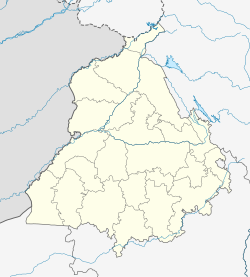Khemkaran
This article needs additional citations for verification. (March 2009) |
Khem Karan | |
|---|---|
| Coordinates: 31°08′42″N 74°32′42″E / 31.145°N 74.545°E | |
| Country | |
| State | Punjab |
| District | Tarn Taran |
| Region of Punjab | Majha |
| Population (2011) | |
• Total | 13,446 |
| Languages | |
| • Official | Punjabi |
| Time zone | UTC+5:30 (IST) |
Khem Karan is a town and a nagar panchayat in Tarn Taran district of Patti tehsil of the Majha region of the Indian state of Punjab.
It was the site of a tank battle in 1965.[1] The Battle of Asal Uttar was the second largest tank battle of the 1965 Indo-Pakistani War. The battle led to the creation of Patton Nagar (or Patton City/Graveyard) at the site of the battle viz, Khem Karan.
History
[edit]Khem Karan is an old town. It was visited by Guru Tegh Bahadur (1621–1675). Previously in Lahore District before the partition of British India. It became a part of Amritsar District afterwards.
Many of the town's residents migrated from nearby villages between 1947 and 1965, such as Nathuwala, Qadiwind, Rohiwal, and Sehjra. The town's Muslim residents migrated primarily to the city of Kasur, 8 km away in Pakistan.
The town used to be accessible to the city of Kasur, Pakistan 8 km away, and to Ferozepur 35 km away until India and Pakistan enacted border controls in 1953 and further restricted travel in 1965. The residents of Khem Karan were essentially cut off from both towns - Kasur lies in Pakistan, while the road to Ferozepur cuts through Pakistan, creating a 70 kilometre detour.
India-Pakistan war of 1965
[edit]On 8 September, the Pakistani 1st Armoured Division and 11 Infantry Division under the command of Maj Gen Nasir Khan pushed an offensive towards Khem Karan, with the intent to capture Amritsar (a major city in Punjab, India) and the bridge on River Beas to Jalandhar.[2] India then launched a counter-offensive. After India breached the Madhupur canal on 11 September, the Khem Karan counter-offensive was halted, affecting Pakistan's strategy substantially.[citation needed] The Pakistani forces engaged with a far advanced and much numbered Indian force comprising only the 2nd Independent Armoured Brigade commanded by Brig Thomas K. Theogaraj, who formed a defensive horseshoe formation to counter the Pakistani force.[3][4][5] But, Khem Karan was captured at last by Pakistan completely.
Demographics
[edit]As of 2011[update] India census,[6] Khem Karan had a population of 13,446. Males constituted 55% and females 45%. Khem Karan has an average literacy rate of 61.55%, lower than the state average of 75.84%: male literacy is 67%, and female literacy is 54.85%. In Khem Karan, 12.14% of the population is under 6 years of age.
The table below shows the population of different religious groups in Khem Karan town and their gender ratio, as of 2011 census.
| Religion | Total | Female | Male | Gender ratio |
|---|---|---|---|---|
| Sikh | 9,103 | 4,276 | 4,827 | 885 |
| Hindu | 3,397 | 1,355 | 2,042 | 663 |
| Christian | 795 | 375 | 420 | 892 |
| Muslim | 73 | 19 | 54 | 351 |
| Buddhist | 4 | 0 | 4 | -- |
| Jain | 2 | 0 | 2 | -- |
| Other religions | 1 | 0 | 1 | -- |
| Not stated | 71 | 31 | 40 | 775 |
| Total | 13,446 | 6,056 | 7,390 | 819 |
Geography
[edit]It is located 56 km from Tarn Taran Sahib. It is in Tarn Taran district.
Politics
[edit]The city is part of the Khemkaran South Assembly Constituency.
Tourism
[edit]In this village is the mausoleum (mazaar) of Sufi saint known as Pir Baba Sheikh Brahm. Twice in a year a fair (mela) is held there.
Economy
[edit]Khemkaran is mostly an agricultural village.
Notable people
[edit]References
[edit]- ^ Stephen Peter Rosen (28 April 1996). Societies and Military Power: India and Its Armies. Cornell University Press. p. 246. ISBN 0-8014-3210-3.
- ^ Gupta, Hari Ram (1967). India-Pakistan war, 1965. Vol. 1 (1st ed.). Hariyana Prakashan. pp. 158–159. ASIN B0006FFBK8. Archived from the original on 7 February 2023. Retrieved 25 August 2020.
- ^ Dandapani, Vijay (18 January 2015). "Unsung hero". The Hindu.
- ^ "Brigadier Thomas Theograj". Retrieved 13 July 2023.
- ^ "Saga of Strategy & Courage". Retrieved 13 July 2023.
- ^ "Census of India 2011: Data from the 2011 Census, including cities, villages and towns (Provisional)". Census Commission of India. Archived from the original on 16 June 2004. Retrieved 1 November 2013.
- ^ https://censusindia.gov.in/nada/index.php/catalog/11389, India - C-01: Population by religious community, Punjab - 2011, Khem Karan (NP)

